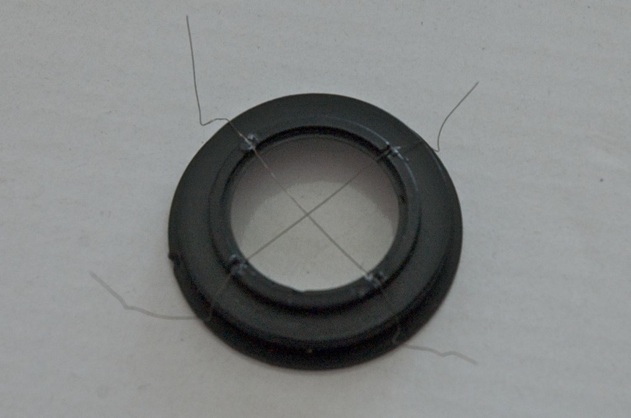
Crosshair Replacement, Zodiacal Light
I needed to replace the Meade 8x50 finderscope crosshairs on my 8" LX200-ACF. It turned out to be a fairly simple and successful operation, as seen in the photo above of the new crosshairs. On Friday, 1 January 2010, I removed the finderscope from its bracket on the LX200. I then unscrewed the eyepiece end from the finderscope tube. Here you can see the eyepiece end partially unscrewed.

Once the eyepiece holder was removed, it was easy to see the crosshairs holder on the inside of the eyepiece holder.

Here you can see the crosshairs after they were attached:

After waiting 24 hours for the glue to dry fully, I carefully cut off the excess wire. I then re-attached the crosshairs holder to the eyepiece holder, Lastly, I re-attached the eyepiece holder to the finderscope tube. I then tested the finderscope to ensure that the crosshairs were in focus. They were. I remounted the finderscope on the LX200.
On Saturday, 2 January 2010, I made my first observations of the new year. I opened the observatory at 1728 MST, temp=64°F. It was clear and calm. First target was Jupiter. I used it to re-align the finderscope to the telescope optics. While waiting for the sky to get darker, I did some Jupiter observing using a 15mm (133X) eyepiece. Two of the Galilean moons were visible, as was a moon shadow on the planet’s disk (which turned out to be from Ganymede). The moons were Io and Europa, shining brightly in the still-bright sky. As the sky got darker, Callisto finally become visible. Here is a screen-capture from my iPhone showing the configuration in SkyVoyager from Carina Software:

At 1800 MST, 54°F, I took a short break to put on warmer boots and get a warmer jacket, scarf, gloves, and cap. I returned to the POD at 1806.
I re-aligned the AutoStar. It had been a couple of months since my last alignment so I decided to start the year with a fresh alignment.
At 1828 MST, with the sky not yet completely dark, I took my first look at a DSO in 2010. It was M1, the Crab Nebula. I used the 15mm eyepiece. I then looked at M45, the Pleiades. I could just make out some nebulosity around some of the stars. At 1842 MST, I looked at M57, the Ring Nebula, which was getting low in the west. This was probably my last view of M57 until it returns later this year, rising in the east in the evening sky. The Milky Way was visible from just past Lyra low in the west, through the zenith, then down to past Orion low in the east.
At 1847 MST, I noticed that the Zodiacal Light was visible! It was easily seen going from the WSW horizon up past Jupiter. The Zodiacal Light and the Milky Way made a “V” in the western sky. The bottom of the V was below the horizon. It was a neat sight! At 1855, with the temperature at 48°F, my wife Laurraine came out to see the Zodiacal Light. It was her first time to see it.
I then went back to observing DSOs. Now that the sky was dark, I went back to M1 and switched to the 26mm (77X) eyepiece. I then went over to M42, the Great Nebula in Orion, always a nice view. I switched to a 2” 50mm (40mm) eyepiece and greatly enjoyed the view. Lots of nebulosity and stars were visible. I then tried for the Horsehead Nebula. I could detect some very faint nebulosity but could not make out a “horse head”. I then went back to M1 to see how it looked in the 50mm eyepiece. It was nice and bright, with a distinct shape. My last target for this first observing session of 2010 was M45 in the 50mm eyepiece. Lots of “diamonds” were visible. Gorgeous!
I closed up the observatory at 1930 MST, 48°F. I am looking forward to many more nights in my SkyShed POD “personal observatory” during 2010.
Sunday, January 3, 2010

